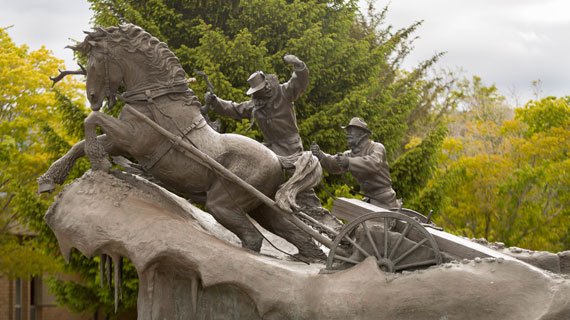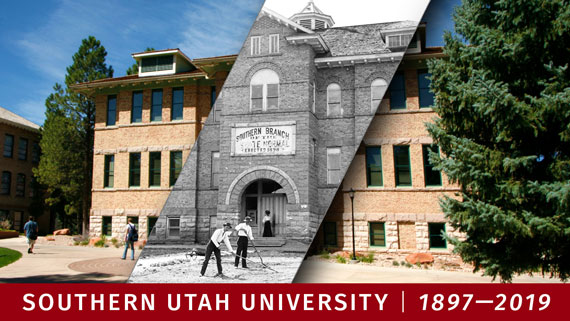The Founding of Southern Utah University
Posted: October 05, 2017 | Author: Southern Utah University | Read Time: 5 minutes
 In the annals of American higher Education, there is no more dramatic founding of a school than that accorded Southern Utah University, nor a more striking example of the extent of the commitment of Utah's early pioneers to the cause of education. The first State Legislature following Utah's statehood authorized a branch of the state's teacher training school to be located in Southern Utah, but the community so selected would have to first deed to the state 15 acres of land and construct on the site a college building to be designed by the architect. When named the site of the new school, Cedar City was a community of less than 1500 people, primarily of English, Welsh and Scottish descent. The community gave the state the title to academy, plans arrived for the new school building, and Cedar City concluded that the construction of such a large building was beyond the town's capacity. Instead, the University was housed in an existing building downtown, and in September 1897 classroom activities began.
In the annals of American higher Education, there is no more dramatic founding of a school than that accorded Southern Utah University, nor a more striking example of the extent of the commitment of Utah's early pioneers to the cause of education. The first State Legislature following Utah's statehood authorized a branch of the state's teacher training school to be located in Southern Utah, but the community so selected would have to first deed to the state 15 acres of land and construct on the site a college building to be designed by the architect. When named the site of the new school, Cedar City was a community of less than 1500 people, primarily of English, Welsh and Scottish descent. The community gave the state the title to academy, plans arrived for the new school building, and Cedar City concluded that the construction of such a large building was beyond the town's capacity. Instead, the University was housed in an existing building downtown, and in September 1897 classroom activities began.
School had been in session for only two months, however, when Cedar City was thrown into its greatest crisis. The teacher's payrolls submitted to the state for payment were refused by the Utah Attorney General who ruled that the size of the downtown building did not comply with the law which required that the school have its own building on land deeded to the state for that purpose. Furthermore, it was ruled that if a building was not erected by the following September, the school would be lost. The immediate task, getting the teachers paid, was resolved by a bank loan secured by three Cedar City families who mortgaged their homes to guarantee payment. The other task, getting the building erected on academy hill, proved extremely difficult. The cost of the building was equivalent to the town's total business volume for an entire year and would require beating the mountain snow to construct the new building. A building committee was appointed to which Cedar City pledged all its public and private resources, the committee being forced to dip into both generously.
On January 5, 1898, a group of men, the first of a long line of townsmen to face the bitter winter weather of the mountains left Cedar City for a sawmill 35 miles away (near present-day Brian Head). Their task was to cut logs necessary to supply the wood for the new building. That expedition, and the others that followed, worked in temperatures that dropped as low as 40 degrees below zero. To protect their legs from the biting winds they tied gunny sacks about their waists and legs. The initial expedition, engulfed by a record snowstorm, attempted to return to Cedar City and was forced to wade through snow drifts that sometimes were 15 feet high and 100 yards long. An old sorrel horse, placed out at the vanguard of the party, is credited with having saved the expedition by walking into the drifts, pushing and straining against the snow, and throwing himself into the drifts again and again until they gave way. Then he would pause for a rest, sitting down on his haunches the way a dog does, then get up and start again. The mountain workers were divided into groups. Some cut logs, some were sawers, some planed logs into lumber, and others hauled the lumber from the mill. It took two and a half days to get a load of logs down from the mountain tops to Cedar City. When heavy snows kept provisions from reaching the working men, they subsisted on a diet of dried peaches. From January through July, they kept up their labors. The bricks for the building, over 250,000 of them, were made by a corps of people who remained in Cedar City, often putting in 12 to 14 hours a day on the project. To purchase building materials that could not be made locally, cash was needed. Some people donated their stock in the Cedar City Co-op store while others offered their stock in the cooperative cattle company. One family gave the siding off their barn, another gave the lumber they had purchased to build a kitchen on their home. Still, others gave prize lumber that had been saved for coffins.
When September 1898 arrived, the building was completed. It contained a large chapel, a library, and reading room, a natural history museum, biological and physical laboratories, classrooms, and offices. It stands today at the end of the founders' walkway, directly east of this monument. Its interior has been remodeled several times but the exterior walls are the original ones constructed in 1898. The first building was literally torn from icy crags and molded by the hands of more than 100 men and women. The community of Cedar City had met its greatest test, and the University was given a heritage unmatched by any other educational institution in the United States. The preservation of the university was achieved by people who would never attend it, indeed some of them never had the opportunity of attending any school. They were hardy, rough-spoken, courageous men and women, people of the type without whom the frontiers of the West could never have been conquered.
THE FOUNDING FAMILIES OF SOUTHERN UTAH UNIVERSITY Listed below are the family names of those who lived in and near Cedar City in the years 1897 and 1898 and whose efforts to preserve the University remain a singular act of heroism and sacrifice for education unique in the history of America.
Adams, Ahlstrom, Andelin, Anderson, Armstrong, Arthur, Ashdown, Ashton, Barnhurst, Barnson, Bauer, Bell, Benson, Bergstrom, Bladen, Bringard, Brown, Bryant, Bulloch, Campbell, Cannon, Carrigan, Chaffin, Chatterly, Clark, Cobaut, Connell, Corlett, Corry, Cosslett, Coswell, Covert, Dalley, Daugherty, Decker, Dix, Dover, Durnford, Dutton, Elliker, Esarry, Evan, Fife, Ford, Fretwell, Froyd, Gibson, Gilbert, Goodfellow, Gower, Granger, Haight, Hallman, Hanson, Harris, Hertwell, Heyborne, Higbee, Holland, Horsely, Houchen, Humphries, Hunter, James, Jensen, Jenson, Jolley, Jones, Lingonsmith, Lambeth, Larsen, Leigh, Lewis, Liston, Lunt, Mackelprang, Macfarlane, Matheson, McConnell, McDonald, MacDonald, McNally, Mausdell, Melling, Middleton, Millett, Mosdell, Muir, Mulliner, Murie, Nelson, Palmer, Parry, Paynon, Pendleton, Perkins, Perry, Pollock, Poynor, Pryor, Pucell, Pugson, Reese, Robinson, Rollo, Rosenberg, Rouche, Sandin, Sawyers, Schoppman, Sheppenson, Sherratt, Shoppman, Simkins, Smith, Snyder, Stapley, Stephens, Stephenson, Stevens, Steward, Stump, Tait, Tate, Talmage, Taylor, Thompson, Thorley, Tucker, Tyler, Unthank, Urie, Walder, Walker, Webster, Westerhold, Shittaker, Wilkinson, William, Williams, Wood, Woodbury Lists Statue sponsors.
This article was published more than 3 years ago and might contain outdated information or broken links. As a result, its accuracy cannot be guaranteed.
Tags: Cedar City Alumni History


